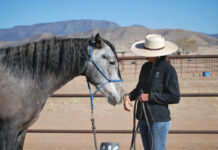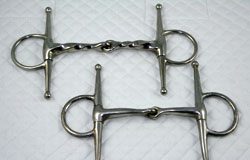Hunter and jumper courses can be tricky. Learning to ride them well can be even harder. Whether it’s a hunter round needing rhythm and cadence or a jumper round that presents unrelated distances to test your mount, understanding the questions being asked on course is the key to a picture-perfect round.

Walk It Out
Schott believes learning how to walk a course is integral to a rider’s education. Typically, you learn to step off a distance in a straight line and then graduate to walking bending lines and more complicated related distances. To learn how to determine the distances in a line, stand with your back touching the middle of the first jump on the landing side, facing the fence you will be riding toward. Take one large, exaggerated step forward, which is about 3 feet. This is the area where your horse will land. From there, continue to take large, exaggerated steps until you reach the second fence. Four 3-foot steps equal one horse stride, which is generally about 12 feet.
If you’re able to take 12 3-foot strides (36 feet) after the initial landing-zone step, the line would be a three-stride. You should then have one additional large step to the base of the next fence. This will allow room for your horse to take off and get his front end out of the way to jump the second fence. If you can take only eight large steps (24 feet), not including the takeoff and landing strides, it’s a two-stride.
The 3-foot area in front of the fence is what Schott calls the “strike zone.” This is the ideal place for a horse to take off from to get a nice, round jump; he should be able to rock back and use his hocks like a spring to power himself over the fence and have enough room to get his knees up and square.
Walking a course before jumping it allows you to see what your horse sees when asked to jump, and shows the different track options you can take. Walking related distances (for example, a galloping three-stride distance to a more compressed two-stride distance) helps you understand how horses have to be prepared to execute a good jump. For Schott, it all comes back to basics: You must truly understand how to make your horse adjustable to ride multiple jumps in a row. After a longer three-stride, you need to be able to land and compress his stride to fit in the following two-stride question.
The more advanced questions include those you might face in a jumper or equitation class, such as jumping a fence and then riding a tear-drop shape (rollback turn) to the left or right to the next fence, or bending lines (two fences not set directly in line with one another).
Adjustability comes into play when you ask for a specific number of strides between fences. The tighter the rollback turn or the straighter you make a bending line, the fewer strides a horse will take to the second fence. You might ride a wider track in a bending line to add a stride, or slice (take a fence at an angle) to safely leave a stride out.

Learning to Commit
Before riding an exercise or course, decide what type of ride you are asking your horse for. Will you hold him and add strides, or will you make a tighter turn and leave out a stride? Afterward, evaluate how well you rode to your plan and where you can improve. “This makes riders accountable for the ride they have,” says Schott. “I want them to learn to make a decision on how they plan to ride a course before they go into the ring. They need to be committed to getting the ride they want.”
This commitment also includes mental planning and visualization, like looking at the next fence. “When my riders tell me how they’ll ride a course, I ask them to tell me every detail, such as ‘I land from the oxer and look to my next fence, sinking into my heels and using the turn to rebalance while still going forward,’” says Schott. “By saying things like this out loud, they have a better chance of remembering to actually do it instead of just saying, ‘I know my course: fence 1, 2, 3’ and so on.”
Build it and They Will Come
Understanding the course from a builder’s perspective will enhance your ability to ride it. For example, ground rails help a horse find the base of the jump to determine where he needs to take off, and riders only jump ramped oxers in the ascending direction for safety so the horse can see the back rail.
An effective warm-up over fences will also enhance your ride. Schott likes a progression from trotting small cross-rails to cantering smaller verticals (under 2’6″) before building to jumping multiple fences in a row at higher heights.
Forward Momentum
An important tool Schott incorporates into her teaching is how to ride forward out of the turns. Many riders have a habit of slowing down as they turn corners. For hunters, it’s usually out of a line, which could lead to a chip and keep them out of the ribbons. Jumpers tend to slow down during rollbacks, which could add time. “Maintaining rhythm is a necessity for riding a nice, steady trip and having the fences come up in stride,” says Schott.
For hunter riders, Schott likes an exercise that forces you to ride into the corner, with lines set a bit closer to the end of the ring than normal. After jumping through the line, halt in the corner instead of letting your horse get heavy on his forehand and rush through the turn. This teaches the value of utilizing the entire ring. “Riders have a tendency to think too quickly about the next fence instead of making the wide, sweeping turns we like to see in the hunters,” says Schott. “Stopping straight in the corner forces you to really think about using all parts of the ring.”
Schott places emphasis on whole-body riding. “Instead of trying to get a halt using only your hands, remember to sink down into your heels and engage your core to halt,” she says. “You may be surprised at how easy it is to get a horse to come back by simply pulling your shoulders back and softly saying ‘whoa.’”
After you master halting in the corners, work on cantering through the corners, even circling in the corners to learn to keep the pace with an even one-two rhythm. “The key to a nice, steady pace is to keep the horse in front of your leg, with an active hind leg,” reminds Schott. “Many riders will need to close their calf or add a touch of spur to remind their mount to keep coming.” Some rings have a tendency to get deeper footing in the corners, so really learning to utilize the corners to balance and move on is key to being able to get down subsequent lines easily.

Adjustability
Schott emphasizes the ability to adjust stride length from the beginning. Learning when a canter is fast and not so fast on the flat will put you at ease whether cantering over rails on the ground or simple jumps, or fitting in strides when jumping multiple fences in a row.
A jump is nothing more than a canter stride” is a mantra Schott teaches, which helps alleviate fear in some riders. When riding either a hunter or a jumper course, think of the fences merely as an extension of flatwork.
To teach adjustability, Schott places two canter poles on the ground. This will give you a feel for how much “whoa” it takes to add a stride and how much “go” it takes to leave out a stride. Moving on to raised cavalletti, the horse is asked to make a small effort that is less intimidating than the effort over a true fence.
Whether you ride hunters or jumpers, the key to a good trip is understanding that there are many pieces to the puzzle; it’s so much more than just getting over the fences. Walking a course correctly, utilizing the entire ring, maintaining a forward pace out of the turns, and finding nice distances are all crucial to a truly nice round.
Liked this article? Here are others you’ll love:
Ask the Expert: Find the Right Distance
Video: Great Grids
Exercise Your Way to an Effective Approach
Based in Lexington, Ky., Sarah Coleman has a soft spot for chestnuts with chrome, including her off-the-track Thoroughbred Chisholm that she’s training to be a hunter.
This article originally appeared in the October 2013 issue of Horse Illustrated. Click here to subscribe!






Great advice, especially about committing!